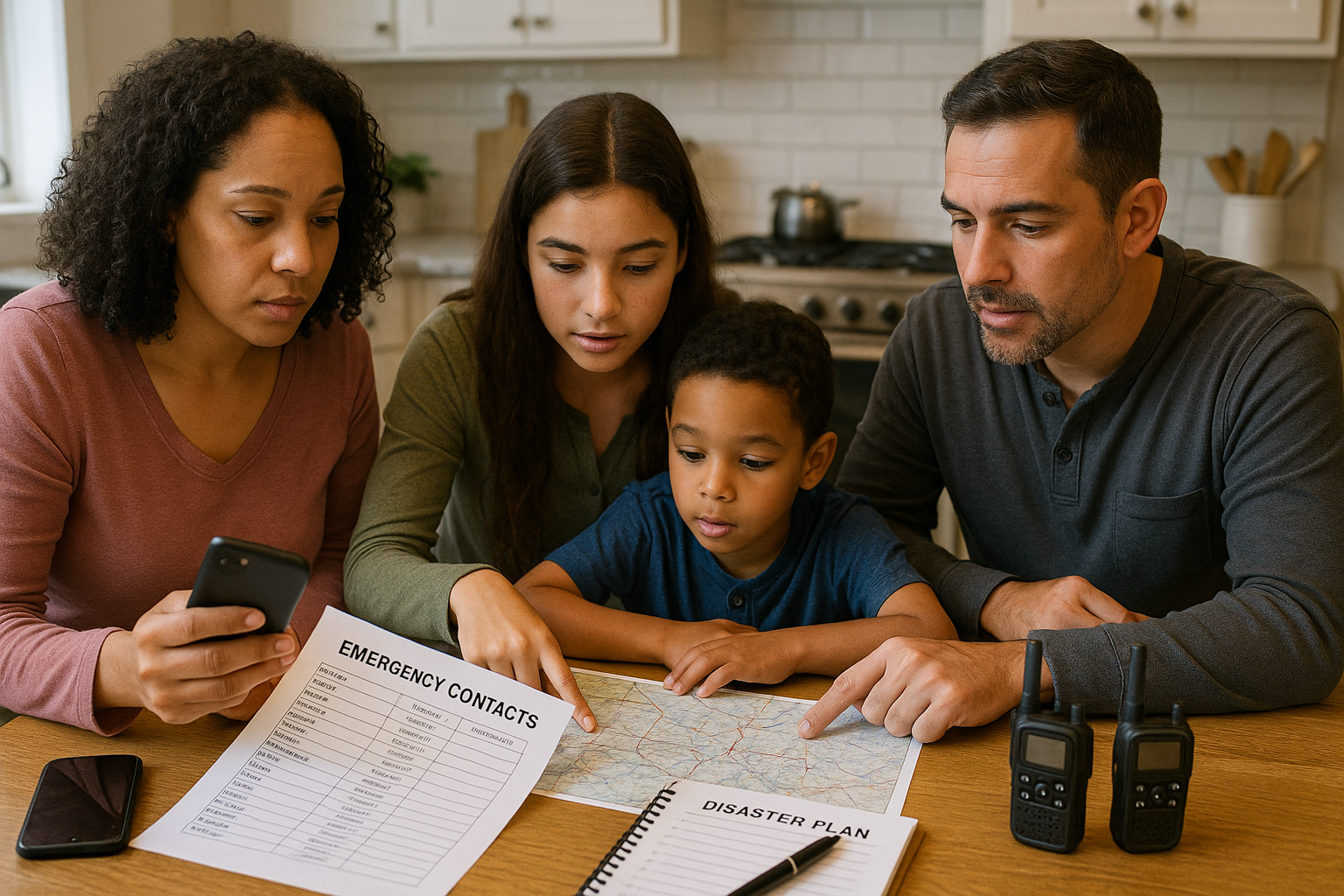Emergencies test even the most prepared. When fear and confusion take over, a clear family emergency plan can make all the difference. Protecting your loved ones goes beyond securing your property or knowing how to shut off your gas. Being ready means knowing how to reconnect when everything else is uncertain. This guide walks you through building a disaster communication plan that brings your family together, keeps information flowing, and helps you act quickly during chaos.
Why You Need a Family Emergency Plan
Disasters arrive with little warning. Cell networks jam. Roads close. Information becomes mixed or delayed. Without a disaster communication plan, family members may panic or become isolated. A dedicated plan keeps everyone on the same page. Each person knows who to contact, how to share critical information, and where to reunite if separated. Prepared families recover faster. They suffer less distress because they can trust in a routine set in calmer times.
A smart family emergency plan builds confidence. Children know what to do when parents are unreachable. Elderly relatives feel less anxiety about confusion during an emergency. The plan fills the communication gap when familiar routines vanish. Even short disruptions become much easier to handle when everyone has clear instructions and a sense of control.
Gathering Emergency Contact Information
Begin by writing down all important contact details. Traditional pen and paper works best since batteries run out. List mobile numbers for each family member. Add landline numbers if available. Include relatives who live nearby as well as those outside your city. If disaster strikes, a relative in another region can relay messages when local networks fail.
Post local emergency numbers in easy-to-find places at home. Fire, police, and ambulance services should be visible near landlines and the main entrance. Store these numbers in every family member’s phone and on printed cards in wallets and backpacks. If regular contact becomes impossible, these external resources give families another lifeline.
A central out-of-town contact is important. Select a trusted person outside your local disaster zone. When phone lines jam, family members can each send a short update to this person. The out-of-town contact can then update everyone else with news or instructions. This prevents looping calls or conflicting information from spreading wide among anxious loved ones.
Setting Safe Family Meeting Locations
Reunification after a disaster causes stress and confusion. Roads may close. Familiar landmarks may be damaged or hard to reach. Pick two meeting spots now rather than during a crisis. One location should be close to home. This could be the house of a friend, a park, or a nearby community center. Pick a second site outside your neighborhood in case returning home is impossible.
Give every family member clear instructions on when to use each site. Review maps together. Identify safe ways to reach these locations by foot, bike, or alternative routes if major roads become blocked. Multiple routes or backup sites can keep your plan adaptable. Children should memorize the nearest meeting spot or carry it written on their information cards.
Coordinate with neighbors if possible. Sometimes others choose the same meeting spots, which allows more adults to watch over children or pets until everyone arrives.
Choosing Reliable Communication Tools
When disaster hits, not every tool works equally well. Cellular calls may not connect, but text messages often go through even on weak networks. Teach every family member how to send a text, even the youngest children and the elderly. Keep written step-by-step instructions taped to the refrigerator or stored with emergency kits for anyone who forgets.
Social media platforms such as Facebook allow quick status updates to a wide group of friends and family. Many platforms created “marked safe” tools that provide peace of mind with a single tap. Email offers another channel, though it depends on Wi-Fi or cell data. Encourage everyone to check in with social channels only after making sure direct family are accounted for first.
Sign up for city or county emergency alert systems. These systems often send automated voice calls, text messages, or emails with real-time updates about evacuation orders, severe weather, or other local threats. Often, officials provide early warnings through these channels before information spreads to national news or the wider internet.
The Role of Information Cards
Create wallet-sized emergency cards for everyone in your household. These cards provide more than just basic identification; they carry critical contact numbers, safe meeting spots, and important medical facts. School-aged children, elderly relatives, and caretakers should all have a card they can access easily at a moment’s notice.
Include contact info for parents, guardians, or anyone else who should be called immediately. List the neighborhood and out-of-town meeting spots. If any family member takes regular medications, suffers allergies, or has special needs, note these on the card as well. Laminating cards keeps them usable in rain or spills. Slip extra copies into backpacks, purses, or emergency kits for added security.
This small investment of time can shorten reunification, support first responders, and protect family members who may be separated from home or unable to speak for themselves.
Special Steps for Children, Elderly, and Pets
Every family faces different challenges. Young children, elderly relatives, and pets sometimes need extra preparation. Start by explaining the disaster communication plan gently but seriously to younger kids. Use age-appropriate words. Practice how to contact parents or trusted adults. Run occasional drills, similar to fire drills, so actions become automatic rather than scary.
Elderly family members may struggle with hearing, mobility, or new technologies. Set up large print versions of the family emergency plan. Consider investing in simple phones with emergency buttons pre-programmed to call key contacts. Talk through every step of the plan in detail. Arrange for neighbors or care agencies to check in if you are far away during an emergency.
Pets depend on you for protection. Prepare a list of supplies so pets can evacuate with your family. Include food, leashes, pet carriers, vaccination records, and contact info for a vet. Identify shelters or hotels outside your area that accept pets in case you cannot return home. Write pet procedures in the same place as your main family emergency plan so nothing is forgotten in a rush.
Practicing and Updating the Disaster Communication Plan
Routine builds confidence. Review your disaster communication plan at least once a year or when major life events change your family structure. Marriage, divorce, children leaving for college, or elderly relatives moving in all require a plan update. Track phone numbers for accuracy. Test meeting locations for safety and accessibility. Update contact info and methods if anyone changes numbers or updates their technology devices.
Hold practice drills twice a year to keep skills sharp. Pretend a different scenario each time: sometimes with no cell service, other times with the roads blocked, or with children at sports practice. After each drill, gather your family and talk through what went well and what needs to change. Practice helps everyone act instead of freeze when disaster actually arrives.
Regular review keeps your family emergency plan ready for the unexpected. Over time, everyone can trust that their safety net is strong, even if nothing else feels certain.
Using Technology in Your Emergency Plan
Digital tools give families an edge during a crisis. Apps and online services allow real-time tracking of severe weather or nearby hazards. Many cities offer opt-in emergency texting systems. Some apps include features for group messaging, location tracking, and sending preset safety alerts with one button press.
Store digital copies of your plan in cloud storage, secured with a password or shared only with family. Text copies to all members at the start of storm season or wildfire season. Equip everyone with external battery packs for their mobile devices to keep phones alive if the power grid fails.
If your area runs warning sirens or text alerts, sign up each phone number to receive automatic notices. Encourage teenagers and tech-savvy relatives to add backup contacts and locations as favorites in their apps for easy access.
Technology fills gaps in coverage but do not rely solely on it. Printed copies, face to face check-ins, and simple radio communication all remain important.
Key Community Resources for Preparedness
Disaster readiness is a whole community effort. Local organizations and public services provide information, emergency kits, and preparedness training. Check the city’s emergency website for guidelines or sign up for alerts. The Austin-Travis County EMS and Austin Disaster Relief Network offer disaster kits and step-by-step family planning materials. Trusted organizations often know the risks specific to your area, such as floods or tornadoes.
Emergency shelters, local fire services, hospitals, and community centers regularly update their plans before hurricane or wildfire season. Join neighborhood emergency groups or attend preparedness fairs to practice drills with others. If you run a business or apartment complex, coordinate with building management to inform everyone about their options.
Follow official city social media accounts and subscribe to city newsletters. Fast and accurate information reduces panic and helps you protect your loved ones when public instructions may change hour by hour.
Emphasizing Routine Over Panic
Being ready removes much of the fear out of disaster. Small steps like checking the battery packs, rehearing how to text, and verifying locations can feel tedious. Slow repetition is reassuring; panic comes from not knowing what to expect. When your disaster communication plan becomes habit, you replace panic with action.
Being proactive is an act of love for your family. Laying out clear instructions, supplies, contacts, and procedures gives every person a chance to respond with skill. It turns chaos into stepwise recovery.
How a Restoration Business Can Help
After years in property restoration, I have seen the cost of delayed or broken communication. Families who plan ahead worry less about their physical space. They can let professionals address water, fire, or storm damage while focusing their energy on care for each other. A restoration business understands that emotional security is as urgent as repairing homes.
If disaster leaves your home unlivable, a prepared family can relocate and check in at their preset meeting spot. This allows for a faster assessment of damage and a focused restoration response. As a restoration professional, I always encourage clients to create or review a family emergency plan before catastrophe strikes. Getting your people together safely is step one. Let the experts handle the rest. Stay connected, stay prepared, recover faster.
Protect What Matters Most
When you create a family emergency plan and stick to it, you give your loved ones the tools to face the unknown with clarity. Communication plans keep stress and confusion from pushing you apart. Simple steps, writing out numbers, choosing meeting places, teaching children, assigning roles, build a tight circle of security.
Every year brings new risks and new technology, but the need remains: keep your family together when disaster happens. No matter the type of emergency, a trusted disaster communication plan is always the most effective protection.


